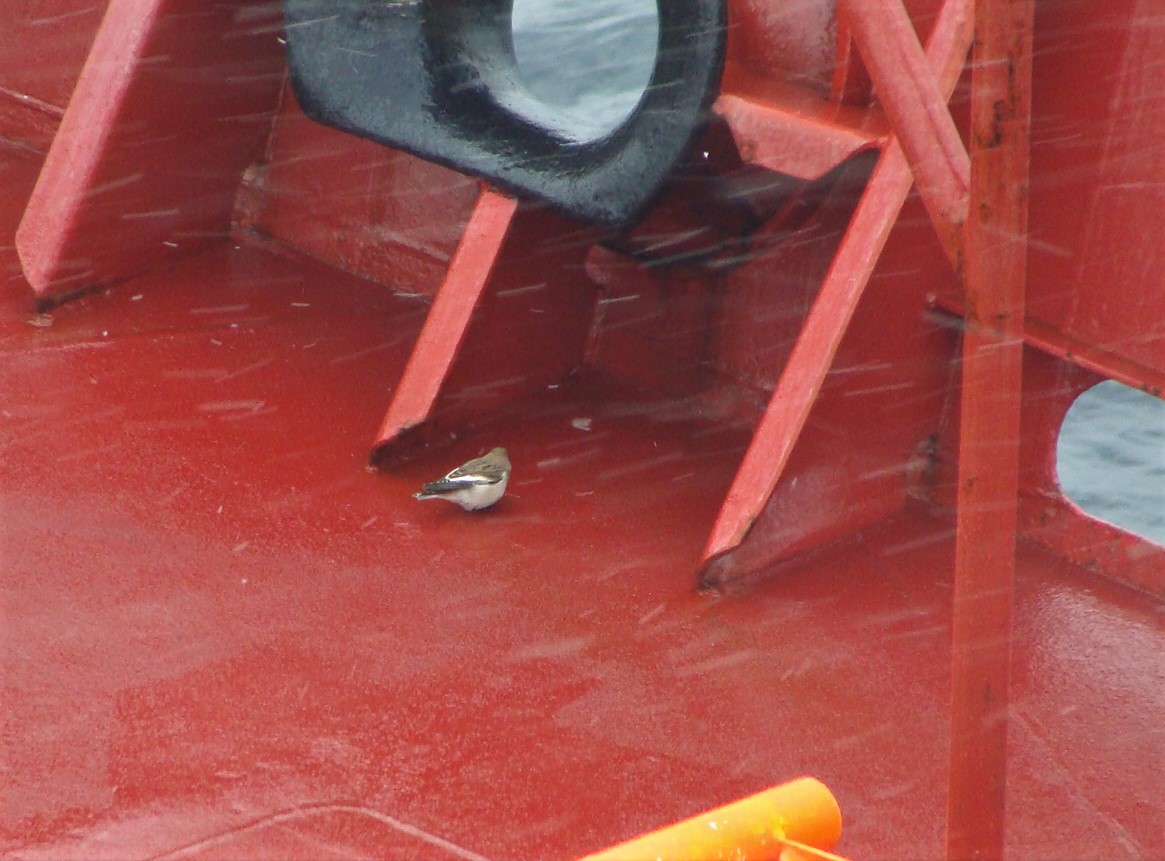It had been a day of tough weather conditions: 25+ knot winds out of the SE were pushing up 3.5 metre waves, blowing the white foaming crests off. All day we pounded through the waves on the icebreaker Amundsen, mapping the sea floor of lower Frobisher Bay….and waiting for a commercial freighter to rendezvous with us so we could assist it through the Northwest Passage – or a version of it. My job on the ship was to count the seabirds I encountered and, thanks to nearby shrimp-fishing vessels, there were lots of them, especially Northern Fulmars. These enterprising birds have come to learn that fishing vessels can be a good source of food and will flock to them as soon as they see them. Unfortunately (or fortunately depending on your point of view) they confused our ship as just another fishing boat – a much bigger one….so maybe more scraps? There were thousands.
But they weren’t the exciting things. A couple of times during the day individual Snow Buntings flew up to the ship, checked it out, and kept going – generally SW. Now we’re about 10-20 miles off the SE end of Resolution Island and there’s a lot of very cold, inhospitable ocean if they miss it. The next land is northern Quebec/Ungava. I’m not sure where these birds would have come from. Eastern Baffin Island? Maybe even Greenland? (We get Greenland buntings in southern Ontario and several that have been banded in southern Ontario – one by us – have been recovered on the west coast of Greenland.) It’s possible.
One young male landed on the ship to get out of the snow but eventually took off again. It’s a good thing; this boat is a death trap to passerines. There’s no food to sustain them and eventually they succumb to hypothermia if they stay. On this trip, on the ship, I’ve seen several White-throated Sparrows, a couple of Common Redpolls, a Savannah Sparrow, and an American Pipit. None of them made it to my knowledge. I found the Savannah Sparrow lying dead on the upper deck; it had simply run out of energy in the 1 degree temperatures and windy conditions.
Late in the afternoon though I was amazed to see a small flock of male Snow Buntings winging their way, obviously on migration. How could they do it?! In these conditions? Well…..it seems they can make the conditions work for them. The wind was blowing hard from the SE so the swell it was pushing up was running NE to SW and moving to the NW. If it helps, get a pencil and paper. Draw a line across the page and mark NE at one end and SW at the other. This line represents the wave and the trough that the birds were sheltering in. They would be moving from the NE to the SW end. Now the wind is pushing that line/wave/trough toward the NW – represented by the top of the page. The resulting direction of movement for the birds is W(est). Get it? Following this strategy those birds would have reached Resolution Island in about half an hour. There they could hunker down and feed – get ready for the next leg – or just keep going until the next major landfall. These birds knew what they were doing and weren’t in that much trouble. Their major concern would be getting spotted by a hungry Glaucous Gull or a Peregrine Falcon – the former are pretty common in the vicinity of the ship and I’ve seen 2 falcons, both well offshore….and hunting.
It’s small wonder I like these small birds so much. They’re survivors.





Thanks Rick sounds a bit rough where you are but also exciting good to hear from you. Hope all is well thanks for sharing a bit of your adventure.